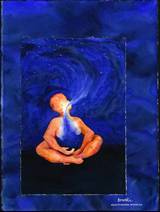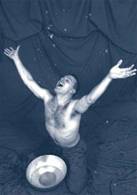
The Ujjayi breath, also referred to as the victorious or ocean breath, is a pranayama.
Ujjayi Breathing is used throughout the entire practice of Ashtanga Yoga. It creates heat, and this heat is said release all of the toxins from the body and mind. It also provides more resistance during the practice.
The Ujjayi Breath basically consists of inhaling and exhaling through the nose. You are supposed to make a noise (like Darth Vader)with the back of the throat during the exhalation.
 Pranayama refers to any technique one uses to breathe consciously. The Ujjayi breath consists of three parts. As one inhales the air will first fill the stomach, then the rib cage, and finally the upper portion of the chest. The Ujjayi breath is taken in through the nose and released the same way. Although the nose does the breathing, the Ujjayi breath is often called the ocean breath because, as the air is inhaled, it passes through the throat. As this occurs, the muscles of the throat are drawn together so that they constrict. The breath should feel as though it is slowly traveling down into the lungs, pushed by the muscles every step of the way. The Ujjayi breath is exhaled the same way. Although it may sound like wheezing, this breath helps to create a steady rhythm.
Pranayama refers to any technique one uses to breathe consciously. The Ujjayi breath consists of three parts. As one inhales the air will first fill the stomach, then the rib cage, and finally the upper portion of the chest. The Ujjayi breath is taken in through the nose and released the same way. Although the nose does the breathing, the Ujjayi breath is often called the ocean breath because, as the air is inhaled, it passes through the throat. As this occurs, the muscles of the throat are drawn together so that they constrict. The breath should feel as though it is slowly traveling down into the lungs, pushed by the muscles every step of the way. The Ujjayi breath is exhaled the same way. Although it may sound like wheezing, this breath helps to create a steady rhythm.
 Ujjayi breathing may be used at any time or during the entire Yoga practice as in the case of Ashtanga Vinyasa Yoga, Vinyasa Flow Yoga, and Power Yoga. Breathing this way ensures that a person takes in enough oxygen and creates enough energy to continue their workout. This breath also cleanses the system of all contaminants. The Ujjayi breath allows a Yogi to change from one asana to the next with ease and grace, while keeping the mind aware of the present moment.
Ujjayi breathing may be used at any time or during the entire Yoga practice as in the case of Ashtanga Vinyasa Yoga, Vinyasa Flow Yoga, and Power Yoga. Breathing this way ensures that a person takes in enough oxygen and creates enough energy to continue their workout. This breath also cleanses the system of all contaminants. The Ujjayi breath allows a Yogi to change from one asana to the next with ease and grace, while keeping the mind aware of the present moment.
Ashtanga Yoga Table of Contents
- What is Ashtanga Yoga?
- Pattabhi Jois
- The Eight Limbs
- Ashtanga yoga mantra
- Ujjayi Breath
- Locks / Bhandas
- Drishti / Gaze
- Vinyasa
- Surya Namaskara / Sun Salutation
- Standing poses
- Padangusthasana
- Padahastasana
- Utthita Trikonasana
- Parivritta Trikonasana
- Utthita Parsvakonasana
- Parivritta Parsvakonasana
- Prasarita Padottanasana A
- Prasarita Padottanasana B
- Prasarita Padottanasana C
- Prasarita Padottanasana D
- Parsvottanasana
- Utthita Hasta Padangusthasana A
- Utthita Hasta Padangusthasana B
- Utthita Hasta Padangusthasana C
- Utthita Hasta Padangusthasana D
- Ardha Baddha Padmottanasana
- Utkatasana
- Virabhadrasana A
- Virabhadrasana B
- Primary Series
- Dandasana
- Paschimottanasana A
- Paschimottanasana B
- Paschimottanasana C
- Purvottanasana
- Ardha Baddha Padma Paschimottanasana
- Trianga Mukhaikapada paschimottanasana
- Janu Sirsasana A
- Janu Sirsasana B
- Janu Sirsasana C
- Marichyasana A
- Marichyasana B
- Marichyasana C
- Marichyasana D
- Navasana (5 times)
- Bhujapidasana
- Kurmasana
- Supta Kurmasana
- Garbha Pindasana
- Kukktasana
- Baddha Konasana A
- Baddha Konasana B
- Upavishta Konasana A
- Upavishta Konasana B
- Supta Konasana
- Supta Padangusthasana A
- Supta Padangusthasana B
- Supta Padangusthasana C
- Ubhaya Padangusthasana
- Urdhva Mukha Paschimottanasana
- Setu Bandhasana
- Intermediate Series
- Finishing Series
- Poster To Go
